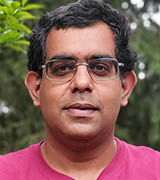Colleagues: Recently Tenured
Meet your recently tenured colleagues: Anirban Banerjee (NICHD), Philip Castle (NCI-DCEG), Hoi Sung Chung (NIDDK), Rebecca F. Gottesman (NINDS), Katie Kindt (NIDCD), and Robin Stanley (NIEHS).
ANIRBAN BANERJEE, PH.D., NICHD
Senior Investigator, Unit of Structural and Chemical Biology and Membrane Proteins, Eunice Kennedy Shriver National Institute of Child Health and Human Development

Education: Jadavpur University, Calcutta, India (B.Sc. in chemistry); Indian Institute of Technology, Kanpur, India (M.Sc. in chemistry); Harvard University, Cambridge, Massachusetts (Ph.D. in chemistry)
Training: Postdoctoral training in chemistry at Harvard University; postdoctoral training in ion-channel biophysics at Rockefeller University (New York)
Came to NIH: In 2012 as a Stadtman Investigator
Outside interests: Listening to bootleg recordings of Indian classical instrumental music; gardening; cooking; learning home-improvement skills
Website: https://irp.nih.gov/pi/anirban-banerjee
Research interests: I am motivated to learn the fundamental chemical principles underlying cellular processes. Currently, my lab and I are examining the structural and chemical biology of membrane proteins. We are obtaining detailed atomic descriptions of the proteins, connecting their structural chemistry with their cellular function in healthy human beings, and trying to understand how structural and functional aberrations are linked to human diseases. We combine a variety of tools such as X-ray crystallography and cryogenic electron microscopy, protein and peptide chemistry, in vitro and in-cell functional assays using a range of biochemical and biophysical techniques, and most recently, high-resolution microscopy. We are currently pursuing studies in two different directions: 1) membrane-embedded enzymes and proteins that use lipids as substrates and 2) transporters that move transition metal ions across the membrane into the mitochondria.
In the first research area, we have solved the first high-resolution structures of members of the DHHC family of membrane enzymes that catalyze protein S-acylation, also known as protein palmitoylation, a form of posttranslational modification that is important in a range of physiological processes (Science 359:eaao6326, 2018; DOI:10.1126/science.aao6326; Structure 25:1337–1347.e6, 2017; DOI:10.1016/j.str.2017.06.018).
In the area of metal transport, we are investigating how iron—which is important in all kingdoms of life from microbes to humans—is transported across cellular membranes. Mitochondria are the cellular hot spot for the biology of iron in eukaryotes. Mitoferrin-1 and mitoferrin-2 are members of the mitochondrial carrier family and were thought to be the only major importers of iron into mitochondria, but no one knew for sure. We devised the first robust in vitro iron-transport assay and demonstrated that mitoferrin-1 does indeed transport iron (J Biol Chem 293:3819–3828, 2018; DOI:10.1074/jbc.M117.817478).
We showed, using the same assay, that MavN,” an unusually conserved protein in Legionella pneumophila, a bacterial pathogen that causes Legionnaire disease, is also an iron transporter that supports growth and invasion of Legionella in the host cell. (Proc Natl Acad Sci U S A 116:17775–17785, 2019; DOI:10.1073/pnas.1902806116).
PHILIP CASTLE, PH.D., M.P.H., NCI-DCEG
Senior Investigator, Clinical Epidemiology Unit, Clinical Genetics Branch, Division of Cancer Epidemiology and Genetics, National Cancer Institute; Director, Division of Cancer Prevention, National Cancer Institute

Education: Carnegie Mellon University, Pittsburgh (B.S. in biological sciences); Johns Hopkins University, Baltimore (Ph.D. in biophysics); Johns Hopkins School of Hygiene and Public Health, Baltimore (M.P.H. in epidemiology)
Training: Cancer Prevention Fellow, NCI-DCEG
Came to NIH: In 1999 for training; became a tenure-track investigator in 2003 and a senior (tenured) investigator in 2010; left NIH in 2011 and held leadership positions in different organizations (American Society for Clinical Pathology in Washington, D.C.; ImmuneXpress, Inc., in Seattle; Global Cancer Initiative, Inc., in Chestertown, Maryland; and National University Health System of Singapore in Singapore) before joining the Albert Einstein College of Medicine (New York) in 2014
Before returning to NIH: Tenured professor of epidemiology and population health, Albert Einstein College of Medicine
Outside interests: Traveling; enjoying food and wine; engaging in outdoor activities (hiking, biking, running, etc.)
Website: https://dceg.cancer.gov/news-events/news/2021/castle-tenure
Research interests: I am interested in the science and translation of cancer-prevention strategies, global health disparities research, and the epidemiology of human papillomaviruses (HPV) and cervical and anogenital cancers. My research program and group are focused on the discovery, development, evaluation, and validation of new technologies for the prevention of cancer, especially those that address global cancer health disparities. We are involved in the following studies: 1) impact of prophylactic HPV vaccination of Rwandan women living with HIV (WLWH); 2) optimal cervical cancer screening strategies in Rwandan WLWH; 3) the efficacy of different ablative treatments for the prevention of cervical cancer in Mozambican WLWH; 4) oral-cavity cancer screening in Assam, India; 5) morphologic and genetic markers of gynecologic cancer; 6) breast-cancer diagnostics in women living in low- and middle-income countries; 7) prophylactic HPV vaccination in pediatric females; and 8) FDA registration trial for self-collection and HPV testing for cervical-cancer screening in the United States.
I have led studies that have contributed critical insights to the design and conduct of randomized trials and cohort studies of the effectiveness of HPV vaccinations, screening regimens, and the natural history of cervical precancer and cancer. Another focus of my research has been the development and validation of new technologies for cervical cancer prevention including HPV tests, many of which have been approved for clinical use by the FDA. My work has enhanced clinical practice and informed the United States screening and management guidelines, notably the implementation of primary HPV testing for cervical cancer screening, and global cervical cancer prevention.
HOI SUNG CHUNG, PH.D., NIDDK
Senior Investigator and Acting Chief, Single-Molecule Biophysics Section, Laboratory of Chemical Physics, National Institute of Diabetes and Digestive and Kidney Diseases

Education: Seoul National University, Seoul, South Korea (B.S. and M.S. in chemistry); Massachusetts Institute of Technology, Cambridge, Massachusetts (Ph.D. in physical chemistry)
Training: Visiting fellow, Laboratory of Chemical Physics, NIDDK
Came to NIH: In 2007 for training; became a staff scientist in 2012 and a tenure-track investigator in 2015
Outside interests: Playing and hiking with his family
Website: https://irp.nih.gov/pi/hoi-sung-chung
Research interests: My lab studies the conformational dynamics of proteins using a technique called single-molecule Förster resonance energy transfer spectroscopy. In particular, we focus on intrinsically disordered proteins (IDPs) that are closely related to various human diseases. The primary goal of our research is to understand the mechanisms of binding and aggregation processes of IDPs.
In our investigations of the IDP binding mechanisms, we are exploring how molecular conformations evolve when two molecules approach to each other, make contact, and form a bound complex. This information is contained in the moment of binding, which can be probed only by single-molecule spectroscopy. In a recent study, we experimentally probed how disordered proteins follow diverse transition paths as they fold and bind to a partner protein, one of the fundamental features of macromolecular dynamics predicted by theories (Science 368:1253–1257, 2020).
We are also characterizing how proteins aggregate. Protein aggregates and oligomers are thought to be implicated in the development of neurodegenerative diseases such as Alzheimer and Parkinson diseases. However, oligomerization and aggregation have been extremely difficult to study due to the heterogeneity of the process. Single-molecule spectroscopy can effectively characterize this complicated process by detecting individual molecular species without separation. Recently, we visualized the formation of fibrils of amyloid-beta peptide associated with Alzheimer disease. We found that the process is intrinsically heterogeneous, which explains highly diverse experimental results on the aggregation of this peptide (bioRxiv preprint 2020; DOI:10.1101/2020.09.10.290023).
REBECCA F. GOTTESMAN, M.D., PH.D., NINDS
Senior Investigator, Chief of the Stroke Branch, and Chief of the Stroke, Cognition, and Neuroepidemiology Section, National Institute of Neurological Disease and Stroke

Education: Columbia College, Columbia University, New York (B.A. in psychology); Columbia College of Physicians and Surgeons, Columbia University (M.D.); Johns Hopkins Bloomberg School of Public Health, Johns Hopkins University, Baltimore (Ph.D. in clinical investigation)
Training: Residency in internal medicine (preliminary), Johns Hopkins Bayview Medical Center (Baltimore); residency in neurology, Johns Hopkins Hospital (Baltimore); clinical and research fellowship in cerebrovascular neurology, Johns Hopkins Hospital
Before coming to NIH: Professor, Neurology and Epidemiology, Johns Hopkins University
Came to NIH: In 2021
Outside interests: Spending time with family; running; baking
Website: https://research.ninds.nih.gov/researchers/faculty/rebecca-fran-gottesman-md-phd
Research interests: Before coming to NIH, I was an investigator at Johns Hopkins University, where my research focused on understanding the cognitive impacts of stroke and other vascular disease, as well as the short- and long-term associations among vascular risk factors, vascular disease, and dementias including Alzheimer disease (AD). I use epidemiology and brain-imaging methods to evaluate the vascular contribution to cognitive impairment and dementia, with an emphasis on the life course. In one of my studies called the Atherosclerosis Risk in Communities (ARIC) study, which had a large cohort, my lab and I found a significant association among midlife vascular risk factors—including obesity, hypertension, diabetes, smoking, and high cholesterol—and increased risk of elevated levels of amyloid plaques, a hallmark of AD. (JAMA 317:1443–1450, 2017).
In another study in the ARIC cohort, we found that many of these midlife risk factors were associated with a higher risk of dementia (JAMA Neurol 74:1246–1254, 2017).
In work led by Keenan Walker (now a PI in the National Institute on Aging), we found that adults with high blood pressure in midlife but low blood pressure in later life had an elevated risk of dementia (JAMA 322:535–545, 2019).
At NIH, I will be continuing my work on modifiable risk factors for dementia, both in the ARIC cohort and also in the DISCOVERY study, a study of poststroke dementia that is enrolling stroke patients at 30 sites across the United States. I will also study cognitive outcomes in patients with stroke and traumatic brain injury, and disparities in these outcomes, and I will evaluate cerebral small-vessel disease and its relation to dementia.
KATIE KINDT, PH.D., NIDCD
Senior Investigator and Chief, Section on Sensory Cell Development and Function, National Institute on Deafness and Other Communication Disorders

Education: University of Wisconsin at Eau Claire, Eau Claire, Wisconsin (B.S. in biochemistry and molecular biology); University of California at San Diego, San Diego, California (Ph.D. in biomedical sciences)
Training: Postdoctoral fellowship at the Medical Research Council (Cambridge, England; postdoctoral fellowship at the Vollum Institute and Oregon Hearing Research Center at Oregon Health and Science University (Portland, Oregon)
Came to NIH: In 2013
Outside interests: Rock climbing; mountain biking; camping; backpacking
Website: https://irp.nih.gov/pi/katie-kindt
Research interests: My laboratory studies sensory hair cells, specialized mechanoreceptors that are required for hearing and balance. In mammals, auditory and vestibular organs are encased in the temporal bone, making it difficult to study how these sensory organs form or function in their native environment. We use zebrafish for our research because in contrast to mammals, embryonic and larval zebrafish are transparent and their hair-cell systems can be studied in vivo. Zebrafish use sensory hair cells to detect sound, maintain proper balance, and to detect local water movements. Many studies have shown that the same core genes are required for hearing and balance in zebrafish, mice, and humans. Therefore, we use this relevant, genetically tractable model by combining powerful functional and time-lapse imaging, electrophysiology, and behavioral analyses to comprehensively dissect the molecular and functional requirements underlying the assembly and function of hair-cell systems in vivo. Our studies provide insight into how to replace and rewire hair cells after hearing loss. This fundamental knowledge is required to develop effective clinical treatments to restore hearing and balance in humans.
In a recent study, we showed that mitochondria regulate hair-cell synapses so they can develop and function correctly. Our results illustrate a mechanism in which presynaptic and mitochondrial Ca2+ (mito-Ca2+) couple to confer proper presynaptic function and formation. Our findings help explain why damage to mitochondria in the inner ear can lead to hearing loss. (eLife 8:e48914, 2019; DOI:10.7554/eLife.48914)
In the future we hope to expand this research to explore how evoked and spontaneous mito-Ca2+ influx are affected by pathological treatments such as age, noise, and ototoxins.
ROBIN STANLEY, PH.D., NIEHS
Senior Investigator and Head, Nucleolar Integrity Group, Signal Transduction Laboratory, National Institute of Environmental Health Sciences

Education: University of North Carolina at Charlotte, Charlotte, North Carolina (B.A. in mathematics and B.S. in chemistry); Yale University, New Haven, Connecticut (M.Phil. and Ph.D. in molecular biophysics and biochemistry)
Training: Postdoctoral fellowship in the National Institute of Diabetes and Digestive and Kidney Diseases
Came to NIH: In 2009 for training; became a Stadtman tenure-track investigator in NIEHS in 2014
Outside interests: Spending time with her family; running; reading; playing the piano
Website: https://irp.nih.gov/pi/robin-stanley
Research interests: My lab is using a multidisciplinary approach that combines structural, molecular, and cellular biology to explore the ribosome assembly pathway. All cells require ribosomes for the translation of messenger RNA into proteins. Ribosome biogenesis is one of the most energetically costly endeavors for a cell, and as a result, the process needs to be tightly regulated with cell-cycle progress and environmental stimuli. Eukaryotic ribosome biogenesis is a complex process that depends on hundreds of assembly factors. Dysfunction of the ribosome-assembly pathway gives rise to a group of human diseases known as ribosomopathies; deregulation of the pathway has been linked to many types of human cancers.
We seek to determine the molecular mechanisms that ensure the accurate and efficient synthesis of the ribosomal subunits. In one study (one of four of our studies selected as an NIEHS Paper of the Year between 2017 and 2020), we used cryoelectron microscopy (cryo-EM) to determine how an essential ribosome assembly drives ribosome production (Nat Commun 10:513, 2019; DOI:10.1038/s41467-019-08373-0).
More recently we have begun to take a multi-disciplinary approach to study how SARS-CoV-2, the virus that causes COVID-19, processes viral RNA to evade detection by host-defense systems. Using cryo-EM-derived models of the SARS-CoV-2 nonstructural protein 15 endoribonuclease—in combination with biochemistry, mass spectrometry, and molecular dynamics—we revealed how this nuclease recognizes and cuts viral RNA. Our findings can be used to aid in the development of effective inhibitors against SARS-CoV-2 (Nat Commun 12:article number 636, 2021; DOI:10.1038/s41467-020-20608-z).
This page was last updated on Thursday, February 3, 2022
